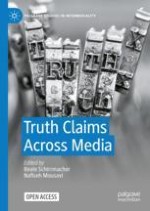Open Access 2024 | Open Access | Book

Truth Claims Across Media
Editors: Beate Schirrmacher, Nafiseh Mousavi
Publisher: Springer International Publishing
Book Series : Palgrave Studies in Intermediality
Open Access 2024 | Open Access | Book

Editors: Beate Schirrmacher, Nafiseh Mousavi
Publisher: Springer International Publishing
Book Series : Palgrave Studies in Intermediality
This book offers an intermedial approach to truthful communication. Bringing together a wide range of media types and interactions from a transmedial perspective, the volume maps out how truth claims are made in different contexts, and how different media promise to create a truthful perception of the social world.
The flexible communicative possibilities of digital technology have a significant impact on our perception of truth and truthfulness of communication. Bot accounts, deep fake videos, or AI technology draw attention to how reliable communication is destabilized and questioned. In this unstable climate, binaries such as true/false, authentic/fake and fiction/facts are difficult to apply. Instead, it is crucial to investigate how media products construct truthfulness in different ways. The volume brings together various media types and contexts such as press conferences, documentaries and mockumentaries, images in magazines and on social media, horror movies, biopics, and educational games and explores how truth claims, authenticity discourses, and knowledge communication are established and how they collide, merge, or are confused.
This is an open access book.